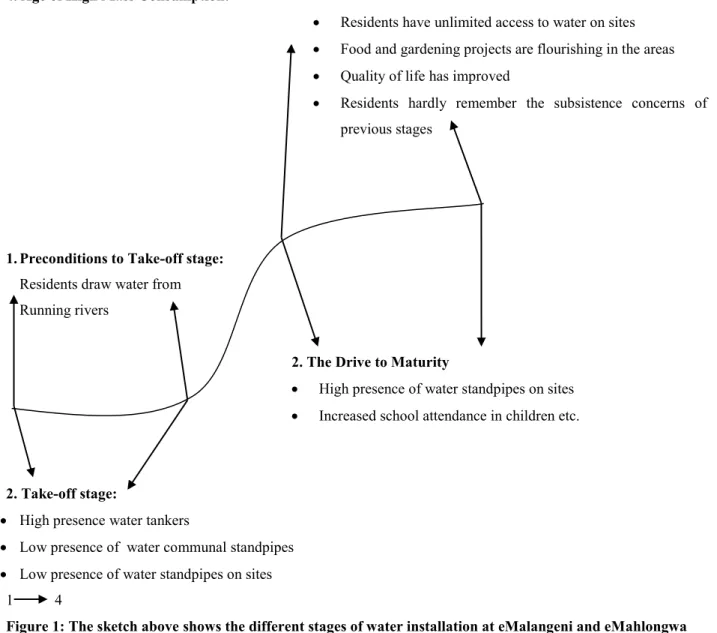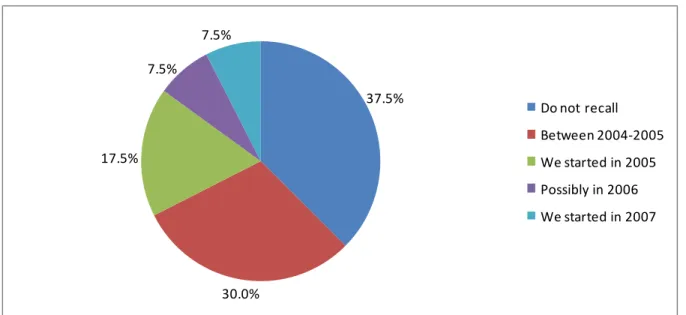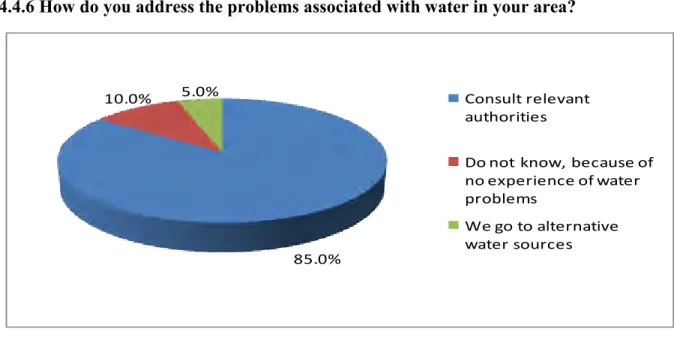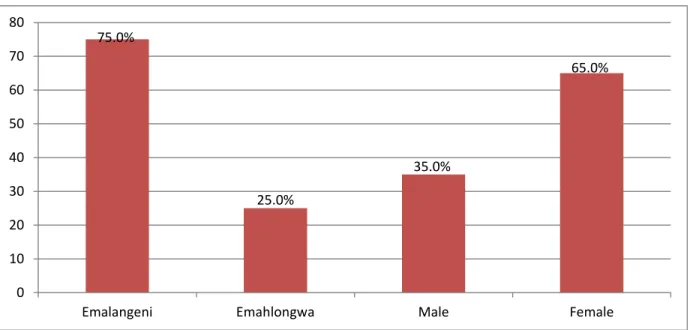Introduction
Background of the study
Ugu District Municipality statistics from June 2008 showed that in 2006, 100 percent of the population of Umdoni Local Municipality had access to water, through municipal or garden taps. However, in the six local municipalities (Hibiscus Coast, uMzumbe, uMuziwabantu, Vulamehlo, Umdoni and eZinqoleni) that constitute Ugu Municipality, it is estimated that a total of 282,580 people are not receiving water under the Reconstruction and Development Program (RDP). standards.
Hypothesis
Goal number seven aims to halve the proportion of people without sustainable access to safe water by 2015. To achieve this goal, an additional 260,000 people must have access to improved water supplies by 2015.
Objectives of the study
Key questions that informed the research
Principal theories upon which the research is constructed
Research methodology and methods
Data collection and instruments
Chapter outline
Before the democratic dispensation, water infrastructure development in South Africa was geared to support the country's wealthy sector, which consisted mainly of the white elite. Most of the land in these homelands was water deficient (Department of Water Resources and Forestry, 1999).
Living conditions of rural communities
Because of the differences between the city and the countryside, most of these people lived in the former homelands, where 75 percent of the population lived on 13 percent of the territory of South Africa. These community committees were referred to as 'Village Water Committees' in Mvula Trust terminology and implemented schemes and as 'Project Steering Committees' in DWAF implemented schemes.
Socio-economic improvements associated with water availability
Household reliance on water
Residents of eMalangeni and eMahlongwa have access to safe drinking water from pipes, despite the fact that the number of shared pipes is insufficient to meet the needs of the growing population in these areas. Francis (2000) argued that women specifically benefit from access to agricultural assets such as community gardens, irrigated plots and secure land tenure.
Water's contribution towards Local Economic Development
- Household usage of water
- Subsistence farming
- Poultry and stock farming
The departments for agriculture, welfare and social development played an important role in the establishment of agricultural activity. The Rural Development Strategy of Umdoni Municipality (2009) notes that agriculture is one of the main strategies for survival and economic activities of the community in the municipality.
Stakeholder participation in water dialogues
Bruch (2000) argued that the participation of the public in decision-making is one of the methods of promoting deliberative democracy. Bruch (2000) considered that approaches that are participatory in nature promote project quality, ownership and sustainability.
Challenges emanating from water installation in rural communities
This includes, among other things, the suitability of the technology to meet the water supply needs of rural communities in every part of the community and under all climatic conditions. It must also be determined whether rural communities have the financial resources and technical capacity to maintain the water system in the long term.
Government response to water challenges
The walking distance to the water supply must be limited to 200m (500m in sparsely populated rural areas). Another important factor to consider is whether or not the water is used for irrigation, although the general priority is domestic water supply.
Theoretical framework underpinning the study
The study found that children are more involved than women in water collection. Of the 1,052 children interviewed in the community, 81 percent had collected water in the previous seven days.
Conclusion
In the stage of high mass consumption, most parts of the two communities involved live in prosperity and their residents are offered both abundance and a multitude of choices. To contextualize, this stage reflects that the eMalangeni and eMahlongwa rural communities have unlimited access to water on site, food and horticulture projects are flourishing in the areas, people's lives have improved and residents of these communities hardly remember the subsistence problems of the previous stages. For example, in this study the researcher wanted to determine the impact of water supply on the quality of life of the people of eMalangeni and eMahlongwa communities.
The researcher conducted this study to determine whether living standards in eMalangeni and eMahlongwa rural areas have improved significantly since they started receiving water from standpipes.
Data collection
The research questionnaire
Open-ended questions allowed respondents to express their views in their own words. Closed questions were used as a way to get clear and definitive answers about water supply. By using closed questions, the researcher was able to take control of the process and obtain uniform and accurate answers.
By using both open and closed questions, the researcher was able to ensure that there were fewer irrelevant or confusing answers to the questions.
The questionnaire intensity
Another advantage of using closed questions is that the answers were easy to standardize; they lend themselves to statistical analysis. It became easy for the researcher to administer the questionnaires, code responses and analyze data.
Piloting the research questionnaire
Research methods
Sampling method
Sampling reduced the level of expenditure and financial constraints; there was no sponsorship or funding for this project. The sampling method used was probability sampling: each member of the population had a known non-zero probability of being selected as part of the sample. This allowed the researcher to know at least some general demographic information: age, gender, class and location of the population.
Such information was important because it enabled the researcher to ensure that areas of uncertainty or ambiguity were clarified.
Systematic sampling
Given the large number of people who have access to water in both communities, sampling was necessary for this study.
Methods of data analysis
Research protocols and ethics
Conclusion
Data analysis
Sample characteristics
Demographic information
Biographical information
In the age category of 60 years and above, 2 (5.0%) respondents felt that their standard of living has improved after the installation of water. Finally, respectively 2 (5.0%) respondents said that they do not know the problems related to water supply in the area. Recently, the respondents pointed out that they do not know if improvement is required in the quality and quantity of water.
Two (5.0%) respondents with primary education highlighted that they do not know what should be improved in water quality and quantity. Two (5.0%) respondents with no income said they do not know what should be improved in water quality and quantity. In this study, most respondents indicated that their living standards improved after the installation of water in the areas.
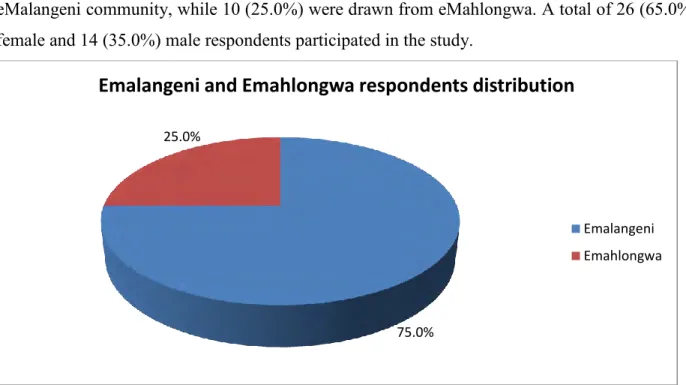
Focus group discussions
Findings of the study
There is a positive correlation between the improvement of the standard of living of the rural communities of eMalangeni and eMahlongwa and the installation of municipal pipes in the areas. This study considered the impact of water service provision on the quality of life of the rural communities of eMalangeni and eMahlongwa and also sought to assess the correlation between the improvement of the standard of living of the rural communities of eMalangeni and eMahlongwa and the installation of municipal pipelines in the areas . What is the standard of living of eMahlongwa and eMalangeni residents after the water installation.
SECTION B: Impact of water service provision on the quality of life of eMalangeni and eMahlongwa rural communities. Ms. Gugu Mthembu Interview on July 31, 2011 Mr. Jackson Nomndayi Interview on August 5, 2011 Mr. Sipho Khuluse Interview on August 3, 2011 Interview of Mr. Sipho Mdlalose on August 6, 2011.
Testing of the hypothesis
Conclusion
The impact of water supply on people's quality of life cannot be assessed in isolation from unresolved water problems. Therefore, the extent to which water supply positively affects each household depends largely on, among other things, a household's walking distance to the pipes, and the time spent waiting at the pipe for their turn to collect water , etc. it has been proven that there is a positive correlation between the improvement of the standard of living of the rural communities of eMalangeni and eMahlongwa and the installation of municipal pipes in the areas.
Conclusion
Has the standard of living of eMahlongwa and eMalangeni residents improved after water installation. In what way has the standard of living in the communities improved since they started receiving water. The model is used to investigate whether the water supply has reached a stage where it has changed the standard of living in the case study communities.
Food and horticulture projects are flourishing in these areas, the quality of life has improved and residents hardly remember the worries of survival in the earlier stages.
Recommendations
The purpose of this study was to assess the impact of water service provision on the quality of life of eMalangeni and eMahlongwa rural communities, as the Ugu District Municipality backlog report revealed that eMalangeni and eMahlongwa rural communities have 100% access to water supply services. The View from Below: Citizen Voice and Regulation in Water Services, Report of the Work of the HSRC Research Group, Pretoria: Water Research Commission. Press Release: Statement by Minister Ronni Kasrils Celebrating 9 Millionth Person to Receive Safe Water Since 1994 (July 5, 2003).
Inhlolokhono kaKaizer Gubevu ngomhla zi-3 kuNcwaba wezi-2011 Inhlolokhono kaNkk Khonjiwe Cele ngomhla zi-3 ku-Agasti 2011 Inhlolokhono kaMnu Khumbulani Ngcobo ngomhla ka-5 Agasti 2011 Inhlolokhono kaMiss Phakamile Jili ngomhla zi-3 ku-Agasti 2011 Inhlolokhono kaNkk Phumzile Shezi ngomhlaka-2711 Agasti Inhlolokhono kaMnuz 2711 Agasti. Thebe Xhosa Interview on 5 August 2011 Miss Sizakele Mthombeni Interview on 3 August 2011 Mr Mandlakayise Mtolo interview on 31 August 2011 Mr Mandlonke Khuboni interview on 6 August 2011 Mr Nkosinathi Msomi Interview on 241 August Miss. mhla zingama-31 kuNtulikazi. 2011 Miss Nobuntu Jali Interview on 3 August 2011 Miss Nokuthula Mzobe Interview on 5 August 2011 Mrs Nokuzola Mdletshe interview on 1 August 2011 Mr Sakhile Gutshwa interview on 5 August 2011 Mr Sangoza Md31losest Interview on the Md31losest interview 4 August , 2011 Miss Siphesihle Zondo Interview on the 3rd August, 2011 Mr.
Bibliography
Appendix
